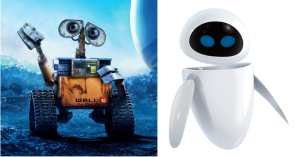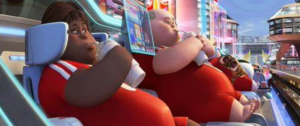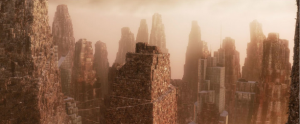50 WALL-E (2008)
What Makes WALL-E So Special
by Jaren Foster
Initially WALL-E is a film about robots, the environment, and love. It’s one of Pixar’s many animated movies that wishes to awe the audience once again with a feeling of adventure and sci fantasy never seen before. Those ideas, scenes, and moments presented throughout the film is what made me fall in love with it for the first time as a young boy and is what still continues to make me love it to this day. What I realized though after this long time of growth is that this movie contains a lot more than first meets the eye. WALL-E is more than just another good Pixar film, it’s a movie that carries themes of power and difference that attempt to convince its watcher of the possible realities of the world we currently live in. This movie is much more than a fun watch or an escape into a science fiction fantasy. WALL-E is a film that uses its animation, plot, characters, and cinematography to show the watcher something they’ve never seen before.
WALL-E was first released in 2008 by the popular Pixar animation studio. This was one of the first films produced by the studio after its acquisition by Disney in 2006. Previously Pixar had already created mega popular hits such as Cars, Monsters Inc, The Incredibles, and Toy Story. To add to this collection Pixar created the film WALL-E which was the one of the first movies they ever did heavily inspired by technology and science fiction. This particular story takes place in a futuristic setting with its main protagonists being the lovable robots WALL-E and EVE. These two are an unlikely duo brought together by even more unlikely circumstances which results in a crazy adventure and the saving of earth and its environment. What made this story all that more compelling and innovative at this time was the fact that technology was rapidly advancing. This film takes advantage of human curiosity about what the future might hold in the age of technology and also the consequences of technology advancing too far. WALL-E uses that wonder, fear and curiosity people had about the possible future of earth and its inhabitants to create a beautiful and unique story.

Though this film focuses on environmentalism and love, one extremely notable concept imputed in this film is in its difference (or lack of it) of characters and representation. First though, I think it’s important to note that the film has two sets of characters, robots and humans. The main protagonists WALL-E and EVE are both robots. Initially it may not seem important to look at the difference in the characters, but when you look closer at each you realize that each is designed and represented to fit within male or female. Robots by their nature don’t have a specific sex as they are not biological. Yet this film decides to portray them as male and female. WALL-E himself is a blocky character in which due to his surroundings is much dirtier and oddly shaped. EVE on the other hand is white ovular robot which presents a much more slim, cleaner, and visually pleasant design. This can be directly correlated to real life films in which many masculine characters are represented as rough, more square, and larger characters while females are often more pretty, colorful and slim. However, the thing that really separates these two characters from classical stereotypes of female and male protagonists are their personalities. WALL-E is a robot whose heart is as big as his curiosity. He is a robot that acts on his feelings in a way that is rarely represented in film for male protagonists. EVE on the other hand is also unique as she takes to action much more than WALL-E and is one who operates on rational thought much more than the male hero. This is very unusual for most classical Hollywood films as most female protagonists are timid, weak, or emotional compared to their male counterparts. These similarities and differences between these characters create a unique combination in which both WALL-E and EVE very much fit within a gender role, yet how that role is represented varies greatly from classical themes.

The second part I wish to bring attention to on the topic of difference in WALL-E is the representation of humans in the film. For the entirety of the early part of the film not a single soul is shown. Earth is stranded and humans are off on a ship called Axiom. It is later revealed that due to the technological advances on this ship, humans have become extremely lazy. This laziness is shown in a scene in which WALL-E first glances upon what human society has become. This scene shows numerous close-up shots of human futures and how this new found laziness has turned them into basically overweight, unintelligent, and careless creatures. From their chubby fingers down to their self-moving chairs which push them every which way the film doubles down on the possible futuristic effects of technology. This horrific idea was just as popular both then in 2008 as it is now in which numerous studies and research show the increased rise of obesity within adults over recent decades. This scene also references how many children and adults now spend more time inside with a screen in front of them rather than outside with friends or interacting with nature. While this film is harsh on its representation of humans it uses the imaginative power of animation to show and even warn people the side effects of our own creations.

At the very center of this film is that of power and its effects on not only humanity but the environment itself. At the very start of the movie, you are introduced to a trash riddled world in which humans are long gone and all that is left are some tiny trash compacting robots in order to clean up the mess. This is revealed to be due to decades of consumerism and corporate ignorance which eventually leads to the corporation Buy n Large having to evacuate all of the remaining humans from the planet. This is a very blatant representation of how in today’s world many people put their trust in corporations which at their core have no good intentions besides the profits and continuation of business. This idea though is not the only sign of power in the film. Another obvious call to power is that of technology on humans. As stated in the last paragraph, in this film humans have become extremely lazy and overweight due to their reliance on technology. The film does not even show humans being able to move around in the film without being catered by the assistance of a robotic chair. This idea tackled the issue of the large increase of technology across the globe. Showing that while technology can grant ease, relaxation, and lesser workload, if given too much power it could even take away from what humans are.
Later in the film, WALL-E introduces you to the main villain, AUTO. AUTO is an A.I robot wheel which acts as the central antagonist of the story. This robot is what causes WALL-E and EVE so much trouble in restoring earth throughout the entirety of the movie. What is different about AUTO though is that it takes the form of a pilot’s wheel in which at the center is a menacing red eye. This can be quickly pointed out as completely opposite of the robots WALL-E and EVE in which they are relatively designed around human sexes. AUTO on the other hand is given almost no human characteristics except his extremely deep menacing voice (This largely impart due to his role in the film being the primary antagonist). You see while WALL-E and EVE are represented by humans and are the protagonist of the story. The antagonist, AUTO, is made to be the exact opposite of human and purely robotic. This idea contradicts the entire role of humans and robots in the film. This film is one that initially centers around two robots and wishes to show the negative effects humanity can have on itself, yet the main central villain who ends up being the one causing all the trouble, is not the corporations, not a human full of greed, but a robot who wishes nothing for the downfall of earth’s environment.
What AUTO shows me about the film is that no movie is perfect. AUTO represents the fact that while the movie talks about many deep ideas it doesn’t exactly nail the issue on the head every time. However, for me even with its faults WALL-E is a movie that I cannot help falling in love with every time I watch it. This film represents more than just one story, one theme or one concept. WALL-E is a film that has so many different ways to approach it that anyone can enjoy or learn something from it. Personally, when I first watched the movie my love for science fiction and robots is what got me intrigued. Now WALL-E interests me as I notice how it uses its scenes, animation and story to convey a plethora of different messages to the watcher. Movies nowadays come in all different shapes and sizes yet the problem with most is that they’re exactly that. A movie with a specific shape and size. WALL-E to me represents a film or project that has no shape and no size. It’s a formless film in which anyone can enjoy in their own way.
What I really wish to do in this paper is emphasize this movie’s creative and powerful themes, motives and scenes while also analyzing how it still fits within a contemporary film. On the surface this film is a love story involving two adorable robots who end up saving the planet and returning it to its natural state. Below the surface the movie tackles the ideas of difference and power in technology, corporations, and humans. However, on top of all these different objectives this film approaches, it still remains as a movie in which people can enjoy even in the simplest of ways. WALL-E still contains that “Pixar magic” that everyone has loved and cared for for years while also separating itself from the huge discography of other movies out there. This film is one that can be appreciated in many different ways, and while still with its faults, is one that stands the test of time as kids and adults alike can appreciate and love the film each in their own unique way.
References
Cheu, Johnson. Diversity in Disney Films: Critical Essays on Race, Ethnicity, Gender, Sexuality and Disability. McFarland, 2013.
Long, Brittany, “Creating Gender in Disney/Pixar’s WALL-E.” (2011). Undergraduate Honors Theses. Paper 149. https://dc.etsu.edu/ honors/149.
Mecchi, Jason, and Ruth Chang. “No, Ignorance Is Not Bliss: A (2020) Review of WALL-E.” Midstory, 20 July 2022, www.midstory.org/no-ignorance-is-not-bliss-a-2020-review-of-wall-e/.
Shaw, Ian Graham Ronald. “WALL-E’s World: Animating Badiou’s Philosophy.” Cultural Geographies, vol. 17, no. 3, July 2010, pp. 391–405. EBSCOhost, https://doi-org.ezproxy.libweb.linnbenton.edu/10.1177/1474474010368609.
“Wall-E Movie Review and Analysis of the Main Message.” WritingBros, 25 Apr. 2023, writingbros.com/essay-examples/wall-e-movie-summary-and-review-of-its-message/
“Wall-E: A Story Inspired by the Bible, Essentialism and Modern Capitalism.” The Angry Vietnamese, 8 June 2017, blogs.ubc.ca/angryvietnamese/2016/02/17/revisiting-wall-e/.
“Wall·E (2008).” IMDb, www.imdb.com/title/tt0910970/fullcredits. Accessed 12 June 2023.
Zavattaro, Staci M. “‘We’ll See Who’s Powerless Now!’ Using WALL-E to Teach Administrative Ethics.” Public Integrity, vol. 24, no. 7, Nov. 2022, pp. 702–16. EBSCOhost, https://doi-org.ezproxy.libweb.linnbenton.edu/10.1080/10999922.2021.1985344.

